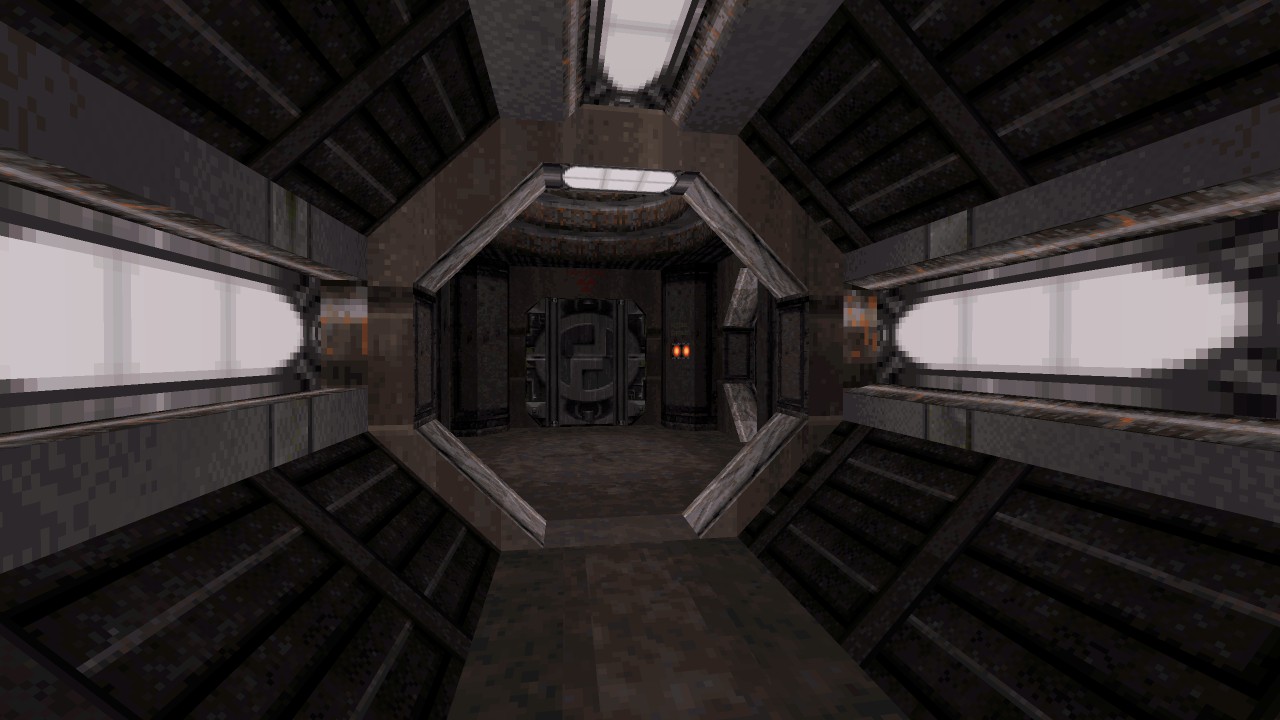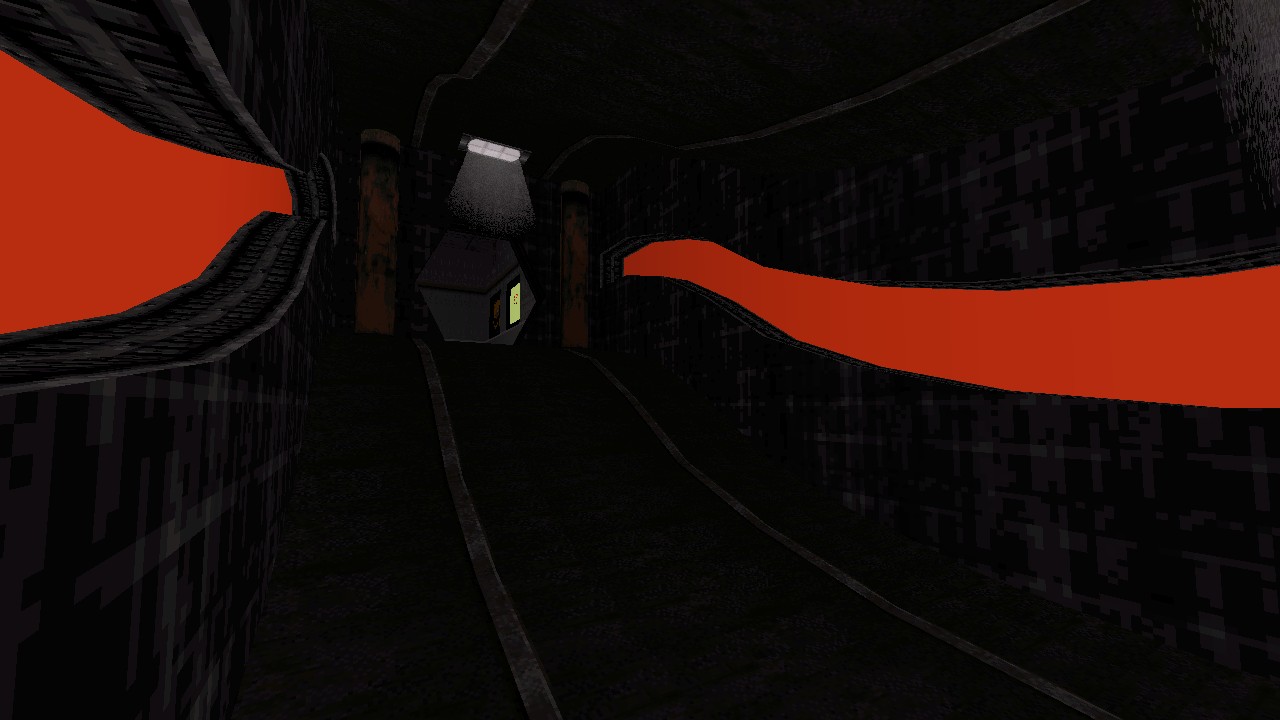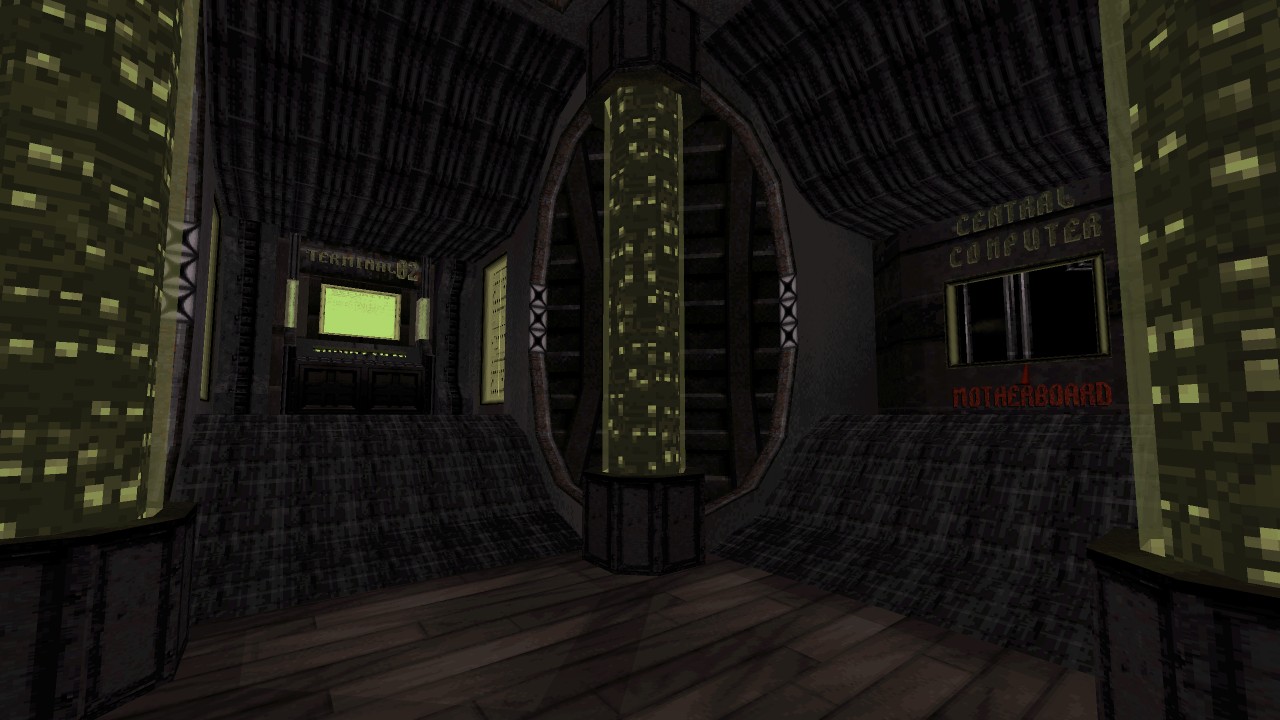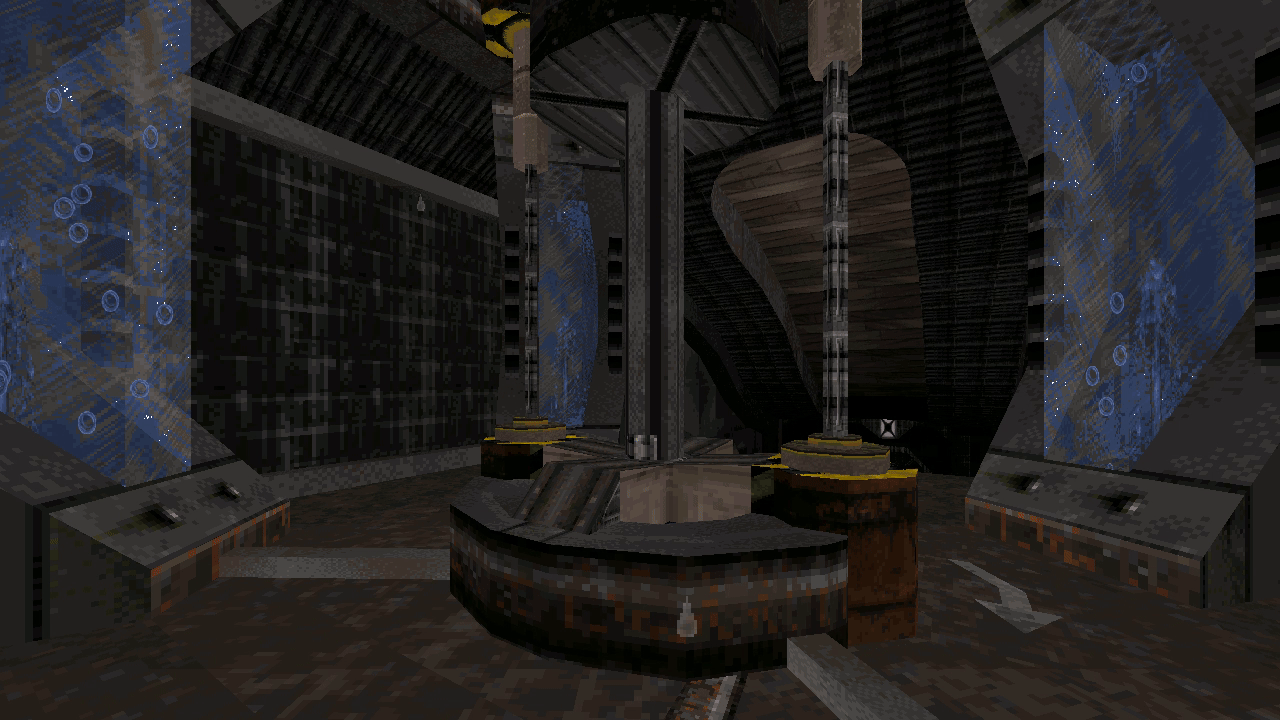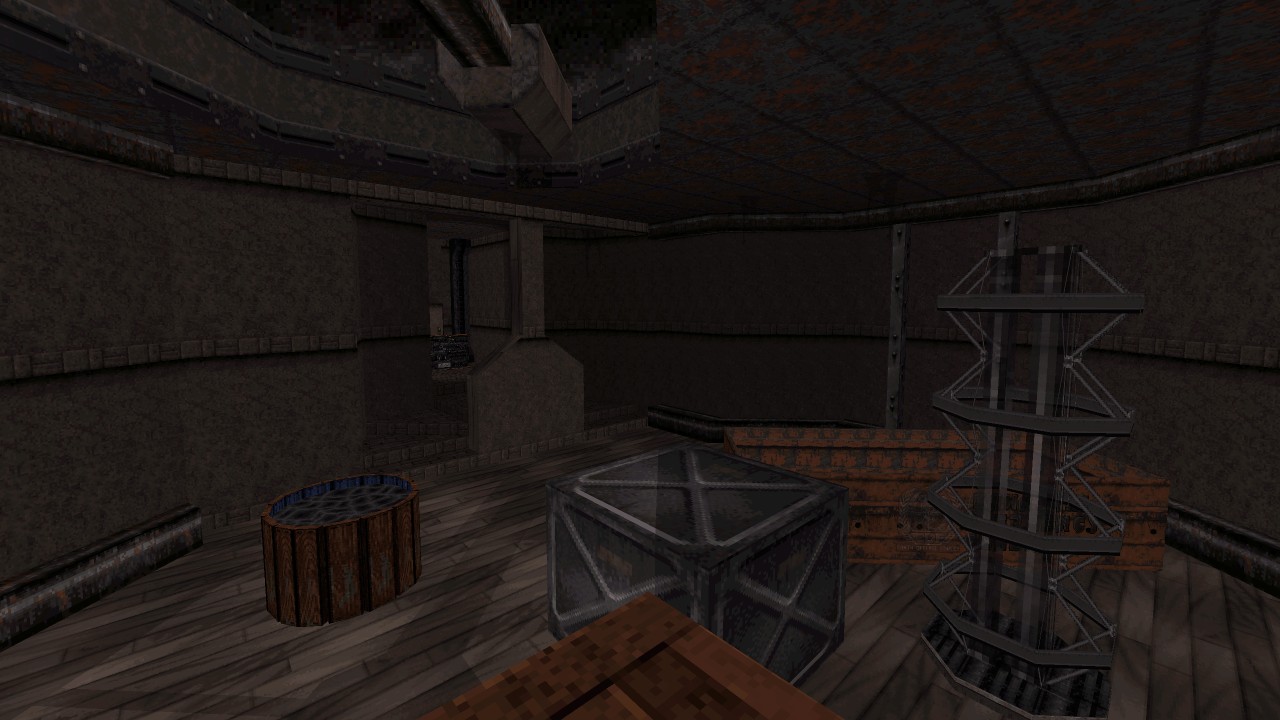Introduction
After some boat trouble and almost becoming food for the sharks, Duke touches down onto an island he’d received an S.O.S signal. There’s a boarded up, abandoned building here and yet the lights still flicker on inside. Checking a nearby computer terminal reveals these power fluctuations are a result of tampering and the central nuclear reactor is close to melting down. There’s only hours left to spare.
Review
In much the same way how the ROCH series made an influence on urban aesthetics in levels for years to come, BOBSP before it otherwise helped to showcase untapped potential lurking within the BUILD Engine from a more technical angle, taking DUKE3D’s existing effects beyond how they were used during the main game by pulling off new tricks. Limitations breed creative solutions, as the saying often goes. According to the included text file it appears Averill had been showing off their discoveries and innovations prior to releasing BOBSP1, back when Dukeworld used to be the hub for everything Duke related. As much as I’d have liked to delve into some historical insights during this time and the initial reception toward the series as each map released, much of those discussions have been lost to time and I wasn’t around before Dukeworld withered away. Old reviews, articles and forum posts throughout those years had not been archived in some form, thus most of DUKE3D’s written history for modding is nothing but leftover scraps. Neither of my brief excursions via the Wayback Machine brought anything of value and any relevant links couldn’t be salvaged. If there’s one regret I have with my time spent in this community was not putting an effort to save what still existed for situations like this. However in hindsight we can at least witness BOBSP’s future results, that even to this day, concepts introduced here have found their ways into many custom levels. Whether inspired by it or one of many cascading derivatives, this paved forward a motion within mapping to squeeze the most out of DUKE3D’s base assets and feature set, with many additional intricacies of these mechanics being discovered during that course having time in the spotlight as well.
[…] Make maps as if you’re mapping for Unreal; don’t think that since BUILD is old that it cant look better than the game levels; it can look damn good, and be interactive in ways other games can’t touch, and my maps are proof. […]
BOBSP1 looks to exist in reaction over the mapping quality around the late nineties, at least one strongly perceived by Averill as being below par, acting as a form of proof there was far more potential for the future of DUKE3D mapping. Even custom levels can go above and beyond those from the official campaign. Tucked at the end of the text file was a little rant or maybe an inspirational speech, hard to tell from its tone, like a call to arms about putting effort behind realising a vision to the benefit of construction, lighting and interactivity. Perhaps some ego might have gone unchecked, but it was clear Averill was proud of their work and wanted to share that passion so that other mappers could draw out their best capabilities. Whether this message alone made any idealogical push onto the scene I have no idea, but the attached level speaks enough for itself, especially if all you’ve been used to playing were 3DR’s official levels, expansion packs and whatever you’ve rummaged off shovelware compilation discs. When I finally got access to the internet at home I’d discovered a site titled Bob’s Duke Nukem Singleplayer Levels (unrelated to Averill) which held a curated selection of the best works around the time with screenshots that salivated wonder and curiosity. I couldn’t help myself from downloading as many maps a slow dial-up connection could manage and the BOBSP series was amongst them. While my beginnings with BUILD were basic and experimental, usually crafting up simple houses and shop streets for my own amusement, Averill’s levels alongside a lot of Glavic’s work soon changed the direction mapping for DUKE3D would appeal to me. I even went so far as recreating a similar curved ramp and utilising a computer terminal for restoring power in my first public release, NUKED1, wearing those very influences on my sleeve.
BOBSP1 is short and linear, a tour through a museum with no proprietor and no visitors beside yourself, as the usual crew of aliens won’t be a present distraction from the sights on display. The prominent focal point then pushes for a showcase of these alternate spins on established formulas during the whole jaunt, all of them aim to enhance feeling immersed within a setting and provide substance to your actions during normal play. Take security monitors as an example, typically assigned as camera feeds in DUKE3D providing brief insights for upcoming areas, except here they’re explicitly used to convey worded messages and objectives to guide what needs to be done. This was a necessity considering how certain features used in this series involved unconventional gameplay to move forward. Upon completing the task set out, taking another peek at the same monitors would see a new message replacement acknowledging a change of state, further establishing your own existence within an environment is not exclusive to moving geometry and exploding walls. Taking full advantage of monitor messages gave mappers an opportunity to tailor very specific tasks for the same end results. This style would eventually taper into a subgenre of their own, especially those taking place within high tech facilities and military base themed levels, following a linear mission by mission structure through to completion. BOBSP1 itself only has two monitors providing simple tasks and more do crop up during sequels. Later community releases such as the works by Glavic or Pinxten would revel in this approach and had gone to become a staple part of map design in general, later branching out into other themes and expanding on storytelling elements via emails or paper documents, recreating the look of websites or perhaps foregoing the security camera and embedding the contents as part of the environment itself.
Taking a short walk away from the foreboding computer terminal will bring you into the coolant pump area, a room where nothing too special is happening at the moment due to being inactive. Power needs to be redirected and on paper it’s a simple process, however a fair number of domino pieces are put into place to make this sequence stand out. For starters there’s a lever for exposing the generator compartment which doesn’t utilise a flat sprite as would be expected, instead constructed out of sectors to depict a handle that twists the opposite direction once activated. What made this simple gesture special that we take for granted was that it reveals more possibilities for including interactivity not bound to the usual rota of switch textures and having extra visual flair . It won’t be the only example either; there’s a handle using an iron grate sprite lowering when pulled and a retinal scanner which denies usage if your tasks aren’t complete by showing a warning. Once access to the generators is acquired, shooting the button here causes a large ground cable to rotate, creating a connection between the power source and coolant pump. The whole room comes alive as loud machinery churns away with all four water tubes now having liquid flow through its system. Rather than limiting these actions to mere suggestion where you’re expected to assume a change of state had occurred once a switch is activated, these results are all done in real time through a convincing presentation of many components coming together. Future releases from the community would eventually amp up how you interact with the environment and their resulting effects during specific events, or even handing over those methods to perceived entities taking action as if you’re not alone, from the puzzle centric Last Pissed Time to haunting set pieces during It Lives.
Forcing objects to attain utility they shouldn’t have has been a common aspect of BOBSP1 so far, but there’s still yet one additional extension of this feature through the ability to pick up and insert a motherboard back into the system it belongs to, all achieved without a single line of code. Of course this object was never once assigned to our actual inventory, simply a matter of smoke and mirrors at play. How this was pulled off is as follows; a circuit board sprite is sunk beneath the floor once a player walks over a nearby touchplate trigger which also activates an item grab sound cue, making it look as if Duke picked up the object in question. Meanwhile, a switch not visible due to the angle of approach is risen where you’ll be placing the motherboard, activating said switch quickly raises the same motherboard sprite into position while other necessities happen in the background. From one perspective it’s not dissimilar to the earlier sector handle, this time an alternative for keycards where a conditional requirement is put into place before another action can follow up. The faux item pickup effect had found many practical uses over the years from having identical functionality found in The Lost Moonbase and X64-2, to map wide scavenger hunts spread across Spacetronic and Submachine to build and repair a device. There’s enough steps for convincing application but not without potential issues cropping up if misused, as no icon appears on the HUD to indicate that your carrying it, so that any accidental retrievals when placed in open spaces could just confuse players. BOBSP1 tried to avoid this possibility by placing the item near a dead end that calls attention to itself, while does make for an odd way to store a motherboard, it was difficult to miss and a compromise worth taking.
Conclusion
While there may have been a few levels in the past making attempts at unique effects or having striking designs, BOBSP1 might not have been the first at everything, but having distilled many components together all at once into a compact experience was a treat to the senses for anyone still using BUILD at the time. Now the series remains as a time capsule that may or may not leave much of an impression to any new blood coming onto the scene, mostly due to recent works having since succeeded these older releases and the lessons they once taught. Every time I return for another run there’s a consistent lingering reminder of concepts I still wish to realise inside this old game and not just from a technical perspective either. Visual design across BOBSP1 as a whole has an undeniable Averill flavour even to this day, in some respects I haven’t come across many levels that approach stylisation quite like this and still find it an inspiring look. Many corridors make up the layout but amongst those is a multitude of sloping curvature and a shape language that exists for the sake of doing so, anything to break up square rooms to be anything but and keep leading the eye. Even doors aren’t exempt from being treated with gloss and glitter, opening up in unexpected ways. If Averill’s Dukematch levels were anything to go by as additional examples, his work clearly takes cues from HALF LIFE, UNREAL and without a doubt QUAKE3 as we’ll see in the sequel.
Download Mirrors
Part of a Series
| BOBSP1: Foreboding | BOBSP2: Paranoia | BOBSP3: Fuel for Vengeance |
| BOBSP4: Sub Species | BOBSPX: Xenocide |
